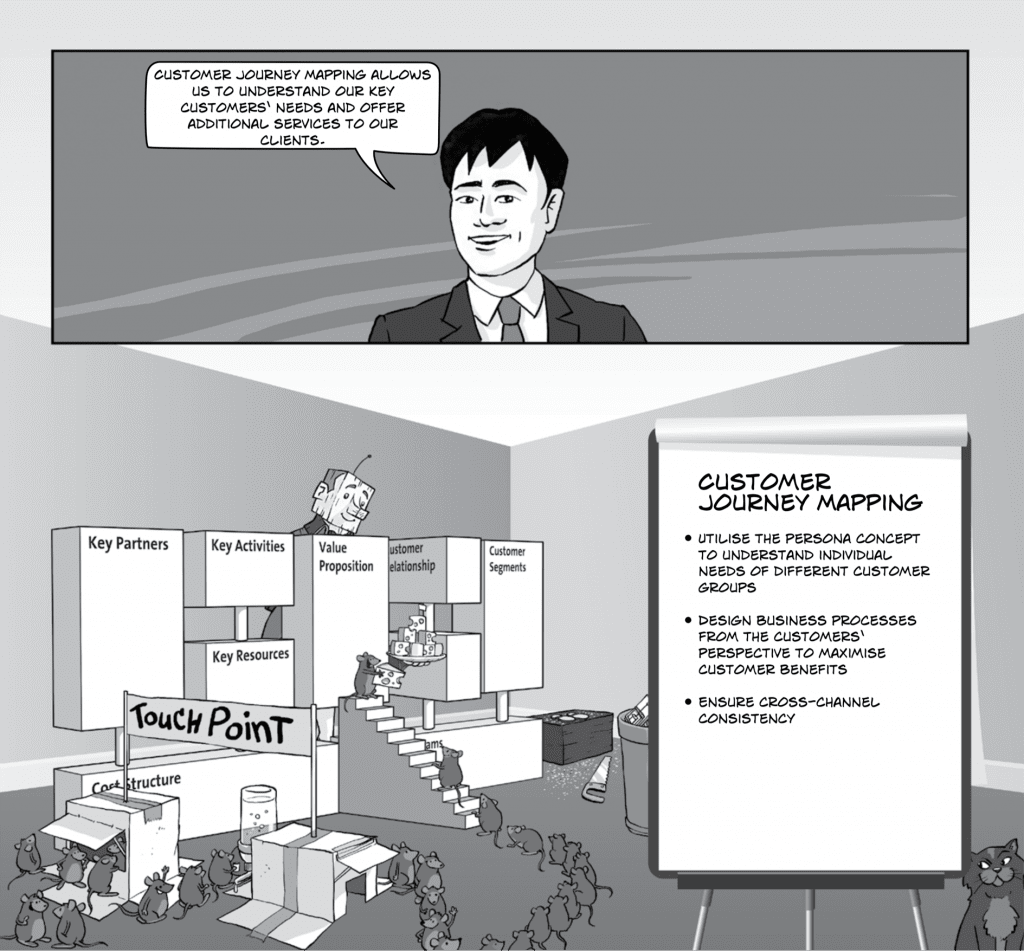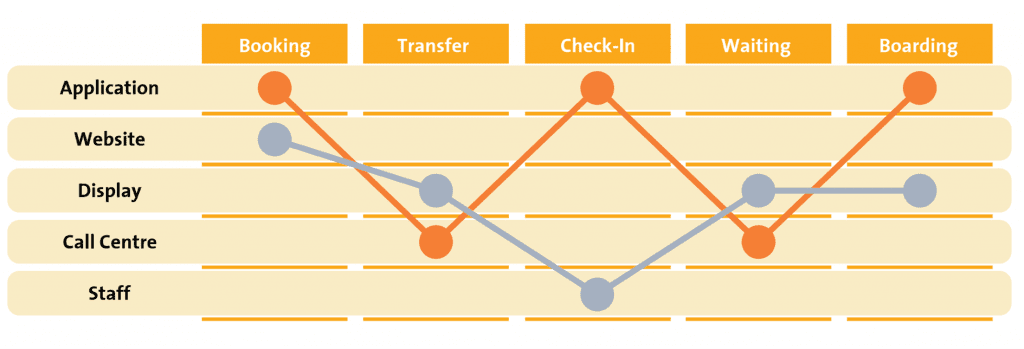As discussed in the ‘Practitioner Edition’, a ‘digital project methodology’ is much-needed for a successful digital transformation. We highlighted that such a methodology must begin with determining the business purpose and customer benefits. In the next step, we derived services, designed a service hierarchy and also debated the importance of staying agile in service modelling. To finish the topic of digital project methodology, we revisit the customer benefit already examined at the beginning of the process. As previously mentioned, customer benefit stands at the centre of the Business Model Canvas, which is recommended for modelling the business purpose.
This section takes a closer look at the needs and behaviours of the customers in order to design their specific customer journey. The phrase ‘customer journey’ refers to the comprehensive experience of the customer through all their interactions, via all applicable interaction channels, with the offered products or services. This starts from becoming aware of the offer, then exploring and comparing the offer, and finally selecting, purchasing and using the product or service.
In order to appeal to a customer’s journey and also to their emotions, we must understand who the customer exactly is in the first place as well as the context in which they are likely to interact.
We recommend the use of the ‘persona’ concept.[1],[2] But what is this so-called persona? To learn more about their customers, businesses develop fictional characters based on customer stereotypes, showing their likely behaviour according to customer segmentation. By creating these personas, companies get to paint an image of their customers and become more aware of what their customers want, what they need or how they interact. Usually, enterprises start out by slowly building up personas based on their existing knowledge of customer segmentation. This know-how should be used to generate the personas. Afterwards, interviews with real people help to gather the most authentic information to make the personas more realistic. Businesses use this data to describe customers’ lives as accurately as possible by giving details of their desires and behaviour, their life circumstances, their environment, and so forth. This helps companies to broaden their horizon of customer behaviour by avoiding preconceptions about customers based on their employees’ own bias.
This strategy brings customer and company closer together through new conditions of understanding. Such a human-centred methodology goes perfectly with the design thinking concepts.[3]
The objective here is to develop and design sequences of customer interaction that end in a positive and consistent customer experience, triggering positive emotions and making the understanding of the customer paramount.
Typically, there are several customer touchpoints with the enterprise’s organisation. The customers rate different touchpoints differently based on the respective customer persona. For example, the business traveller rates a speedy check-in and security experience higher than a leisure traveller would. Taking the customer’s perspective also means considering touchpoints that are provided by other organisations while modelling a satisfactory customer journey. Only organisations that are able to create an exceptional customer experience can set themselves apart from their competitors.
The following provides an example of such a persona concept: imagine a business traveller travelling alone, and a father travelling with his family. Despite both personas potentially having the same starting point and destination, their overall journey may look very different. While the business traveller, for instance, arrives at the airport by taxi, hoping for a relaxing flight or to get some work done, the father on holiday with his family is more likely to arrive by car or public transport. His main concern is a safe flight and keeping his children entertained.
As different personas behave individually, user experience has to be tailored to each persona’s needs. While the business traveller and the family father have different customer journeys, they might use the same or similar services, but they are more likely to use them in a different order or with a different focus. Both travellers travel with luggage, but while the business traveller only carries hand luggage, the family father may bring along several suitcases, showing that each persona executes the right to carry luggage in a unique way.
Traditional business process modelling takes a different approach to the one shown in the diagram. Business processes were typically designed through the perspective of the company, whose main objectives were efficiency, standardisation and compliance. Companies tended to ignore their customer’s individuality.
In a digital world, we have to turn this around, making the customer and their individual behaviour the ultimate decision maker.
The thoughts of any customer revolve around their own journey. Therefore, it is evident that different touchpoints should provide a consistent view and contribute to the customer’s needs. So, it is not the number of touchpoints that is paramount, but rather the end-to-end customer experience.
Having this in mind, companies must thoroughly analyse how different touchpoints work and interact with each other. For example, an airline’s app, displays at the airport, website, check-in desk, etc. must support a traveller based on the same business rules and data.[4] Companies can also, based on their customer personas and the question ‘Who brings a higher value to our company?’, focus initially on improving areas that add more value to the higher-value customers as opposed to focusing on areas and touchpoints that may not matter as much. In order to succeed in the digital age, it is essential for businesses to consider their customers’ individual journeys in the design of their business processes. We strongly advise enterprises to implement the methodology of the persona concept by getting to know their customers’ behaviour, environment and desires in intimate detail.
Last, but not least, we want to suggest not only considering the customers’ needs at the design time, but also building a continuous feedback loop into the business processes. An enterprise that precisely knows the satisfaction level of its clients can react instantly. In order to achieve that, it is important to define measurable KPIs such as waiting time, percentage of successfully finished transactions or number of ‘likes’ on social media.
_____
[1] Lidwell, W., Holden, K., Butler, J.: ‘Universal Principles of Design’, Rockport Publishers, p. 182, 2010.
[2] Nielsen, L.: ‘Personas – User Focused Design’, Springer, 2013.
[3] Uebernickel, F., Brenner, W., Haef, T., Pukall, B., Schindholzer, B.: ‘Design Thinking: Das Handbuch’, Frankfurter Allgemeine Buch, 2015.
[4] Wilson, H., Street, R., Bruce, L.: ‘The Multichannel Challenge: Integrating Customer Experiences for Profit’, Routledge, p. 118, 2008.



